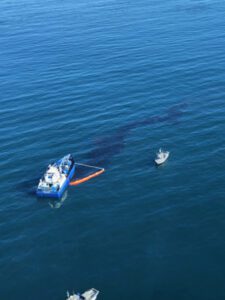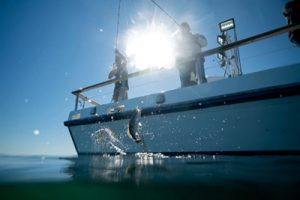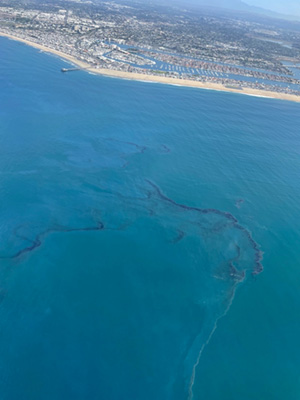
The sizable oil spill in October off the coast of Orange County caused by an anchor-dragging incident has reportedly not had an impact on maritime shipping at local ports, although it has prompted state policymakers to investigate how to prevent it from happening again, including possible future legislative changes.
The oil spill itself doesn’t appear to have immediately affected maritime goods transport to and from Southern California ports, as confirmed by multiple representatives to Pacific Maritime Magazine.
Operations at the Port of Long Beach were not directly affected by the oil spill, said Port of Long Beach Executive Director Mario Cordero. There have been no changes in security protocols at the port either, he added.
There was also no impact on ships entering or leaving the Port of Los Angeles, according to POLA spokeswoman Rachel Campbell.
Just south of the spill, there was also no change in the Port of San Diego’s maritime activity, confirmed port spokeswoman Marguerite Elicone.
Pacific Merchant Shipping Association President John McLaurin said in an email that there was likely minimal to no impact regarding movement of vessels in/out of port. Although he believes some precautions were taken with respect to inspection of ships to ensure they didn’t have oil coming off their hulls—and probably cleaning protocols once they got into port.
U.S. Coast Guard Lt. Commander Jeannie Shaye, the public affairs officer for the Eleventh District, which covers the California coast, confirmed in an email that there were no changes to shipping lanes.
The joint state Assembly committee that formed following the oil spill had its first oversight hearing on Nov. 15 to discuss response, recovery, and prevention, and possible future policies were a notable part of the discussion.
As officials gather to discuss the oil spill, and consider the recent port congestion, any new regulations will take time to proceed through the legislative system.
The California Legislature is scheduled to reconvene in January with the bill introduction deadline on Feb. 18.
Oil Spill Prevention and Response is currently engaged with state legislators to explore options for new legislation that could bolster OSPR’s response and preparedness programs, said California Fish and Wildlife—OSPR spokesman Eric Laughlin.

Crowded Waters
With a record number of ships anchored offshore in Southern California, which has been steadily increasing throughout 2021, things were getting crowded out on the water prior to the Oct. 2 oil spill.
Most or all anchorages were likely filled at the time of the spill, including the contingency anchorages, along with vessels probably drifting offshore.
The day before the spill, Marine Exchange SoCal reported that 142 total ships were in port in LA/LB, including 82 at anchor or drift areas and 60 at berths. Of the 142, there were 90 container ships, (61 at anchor or in drift areas and 29 at berth.).
The situation prompted an Assembly and Senate select committees on Ports and Goods Movement Nov. 3 meeting with the topic: “The Perfect Storm: California’s Port Congestion and Goods Movement Crisis.”
California Association of Port Authorities President Danny Wan explained at the meeting that the current congestion is partly the result of decades of underinvestment in the ports and supply chain.
Committee Chair Patrick O’Donnell (D-Long Beach), whose district covers both the Long Beach and Los Angeles ports, noted at the meeting that the San Pedro Bay ports are responsible for 40% of the country’s imports and 25% of the exports. With so much cargo floating through the California ports on a daily basis, the backlog has brought national attention to the issue.
It’s currently on the brink of “significant disruption” to the global supply chain, O’Donnell said. The major increase in cargo volume in California, caused by a “perfect storm of factors” including increased consumer demand and COVID-19 shutdowns, all have led to congestion and strain.
“The ships are full, the docks are full, and the warehouses are full,” O’Donnell said.
There are dozens of ships off the coast waiting for their turn to unload cargo. The line is long and wide, he said.
The congestion concerned some officials in the Nov. 15 joint Assembly meeting on the oil spill, with many worried another incident could happen in the near future.
Assemblymember Janet Nguyen (R-Huntington Beach) wanted officials to follow-up with details on whether or not the cargo ships are given notice to the location of the pipelines as they approach the coast, and when and how.
“There are so many (pipelines) out there, and now that we know it is a cargo ship, we want to make sure it doesn’t occur again,” Nguyen said.
The anchor-dragging incident was caused by a large container ship in close proximity to the subsea pipeline and triggered thousands of gallons to spill into the Pacific Ocean.
Shaye noted in a Nov. 11 email to Pacific Maritime that Coast Guard officials have “high confidence” that the leak was about 25,000 gallons. A multi-agency Natural Resources Damage Assessment has been established and will evaluate long term impacts to resources, she said.

Incident Investigation
Coast Guard investigators determined that the Mediterranean Shipping Company (MSC) vessel DANIT was involved in a Jan. 25 anchor-dragging incident during a heavy weather event, according to a USCG statement. The incident occurred close to the subsea pipeline that was the source of the Orange County oil spill.
As a result, the Coast Guard designated vessel operator MSC and vessel owner Dordellas Finance Corporation, as parties in interest to the marine casualty investigation.
Darius Kirkwood, public affairs specialist for Pipeline and Hazardous Materials Safety Administration, told Pacific Maritime that PHMSA is working alongside state and federal counterparts focused on mitigating any immediate damage stemming from the pipeline incident and preventing any potential for a future incident.
On Oct. 4, a Corrective Action Order was issued to Beta Offshore, an Amplify Energy subsidiary, the company that owns the ruptured pipeline. The order requires that the pipeline remain shut until a number of measures are undertaken, Kirkwood explained. PHMSA retains authority to review and approve or disapprove of any restart plan.
The order includes comprehensive reviews of in-line inspection results for the pipeline, as well as other records that may inform the root cause and determine whether those conditions exist elsewhere on the line. The order also requires mechanical and metallurgical testing of the failed section of pipe as well as a Root Cause Failure Analysis facilitated by an independent third party.
Investigation of the incident’s cause is ongoing, Kirkwood said. PHMSA may require additional actions or amendments to the CAO if warranted, and the agency retains the ability to take other enforcement actions, as appropriate, including civil penalties.
Amplify was also invited to the Nov. 15 joint Assembly committee hearing, but no representatives from the company attended. In a letter to committee members, Beta Offshore Vice President Dan Steward wrote that “given the various ongoing investigations into this incident, we are not in a position to responsibly answer your questions at this time.”
California Department of Fish and Wildlife Director Chuck Bonham said at the Nov. 15 oversight hearing that there are several areas for improvement to help prevent this from happening again.
“We can get better, we have to get better,” Bonham said. “We have to adapt. Resiliency is the measure of learning from your lessons.”
Another needed area of improvement, Bonham noted, regarded the closure of the fisheries. Fisheries were closed during the cleanup and by Nov. 3, scientists, with the help of commercial fishermen, completed initial seafood sampling along the Southern California coast to determine impact on fisheries and sent samples to the lab.
After 645 square miles were closed to commercial fishing for a number of weeks, the state Department of Fish and Wildlife in late November reopened Southern California fisheries after it was determined that fish in the spill area no longer were unsafe to be consumed by humans.
Labs tested for polycyclic aromatic hydrocarbons, which are found in oil and can accumulate in species caught for human consumption, causing an increased risk for cancer and other adverse health conditions.
After analyzing the results, officials from California Office of Environmental Health Hazard Assessment made the recommendation to lift the closure based on sampling data.
“There is no further risk to public health from seafood consumption in the affected area,” the Department of Fish and Wildlife said in a Nov. 29 proclamation. “Fishing and consumption of seafood from the area can resume.”

